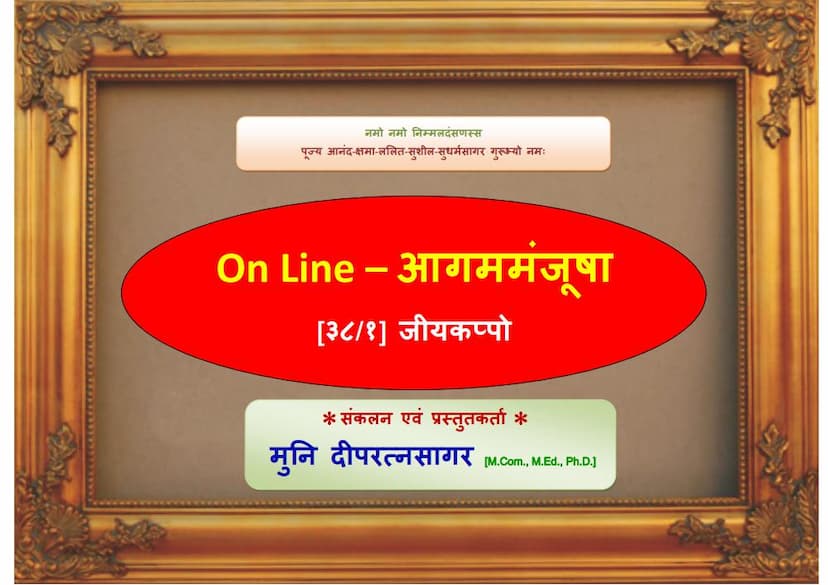Aagam Manjusha 38A Chheyasuttam Mool 05 A Jiyakappo
Added to library: September 1, 2025

Summary
This Jain text, "Aagam Manjusha 38A Chheyasuttam Mool 05 A Jiyakappo," compiled and presented by Muni Deepratnasagar, is the fifth of the Mool Sūtras from the Chheya Sūtra category within the Agam Manjusha series. The original Agam Manjusha was edited approximately 70 years prior, in Vir Samvat 2468 / Vikram Samvat 1998 / AD 1942, by the revered Āgamoddhārak Āchārya Shri Ānandsāgarsuri Maharaj Saheb. This online version from 2012, in Vir Samvat 2538 / Vikram Samvat 2068 / AD 2012, aims to present the same content with some useful modifications, making it accessible online for the first time.
Key points highlighted in the introductory material:
- Continuity and Legacy: The text emphasizes the continuation of the path laid by Āchārya Shri Ānandsāgarsuri Maharaj Saheb.
- Evolution of the Edition: Several points are noted about the differences between the original Agam Manjusha and this online version:
- Āvaśyaka Sūtra (Agam-40): Includes not just the root Sūtras but also their Niyukti (commentary).
- Jitakalpa Sūtra (Agam-38): Includes the root Sūtras along with the Bhāṣya (further commentary).
- Jitakalpa Sūtra (Agam-38) - Alternative "Panchakalpa": The Bhāṣya of the alternative "Panchakalpa" is also included.
- Oghaniryukti (Agam-41) - Alternative "Piṇḍaniryukti": While included, its printing location differs from the original.
- Kalpa (Bārsā) Sūtra: This has also been included in the Agam Manjusha.
Content Summary of the Jitakalpa Sūtra (Pages 3-54):
The core of the provided text is the detailed commentary (Bhāṣya) on the Jitakalpa Sūtra (Jīyakappo), which is a significant text within Jainism, particularly related to monastic conduct, disciplinary rules, and purification rituals. The commentary is extensive and covers a wide range of topics. While a complete word-by-word translation is beyond the scope of this summary, the key themes and concepts discussed include:
-
Vyakhyānas (Explanations) of Key Terms: The text begins by explaining terms like "Pravachan," "Jiva," "Acharya," and the concept of "Pāyachitta" (atonement/penance), tracing their etymology and meaning.
-
Types of Knowledge (Jñāna): It delves into the different types of knowledge, particularly Avadhi Jñāna (clairvoyant knowledge) and Manahparyavāy Jñāna (telepathic knowledge), discussing their characteristics, classifications (e.g., Bhavapratyaya and Kshayopashamik), limitations, and scope.
-
Vyakti (Manifestation) and Vyooha (Arrangement) of Knowledge: The text describes how these types of knowledge operate, their potential for growth and decline, and how they are perceived.
-
Conduct and Penance: A significant portion is dedicated to explaining various aspects of Jain monastic conduct, including:
- Acharan (Conduct): Discussing the principles and practices of virtuous living.
- Pāyachitta (Penance/Atonement): Elaborating on the necessity, types, and application of penances for various transgressions or mistakes made by ascetics. This includes detailed explanations of different categories of penance based on the nature of the offense, the ascetic's state, and the prescribed purification methods.
- Samiti (Vigilance): Explaining the five types of vigilance essential for monks to avoid harm.
- Gupti (Restraint): Discussing the three types of restraint (mind, speech, and body).
-
Āchāras (Conduct Rules) and Niyukti (Commentaries): The text extensively explains the rules governing the conduct of monks, including their daily routines, interactions, dietary practices, and the importance of adhering to the Niyuktis and commentaries.
-
Types of Ascetics and Their Rules: It discusses the specific rules and conduct applicable to different types of ascetics, including those who are learned, those who follow strict vows, and those who might be facing specific challenges.
-
Vyakhyānas of Specific Practices: The commentary delves into the intricacies of various practices, such as:
- Āchāra (Conduct): Detailing the behavioral norms.
- Ārambha (Beginning/Initiation): Rules related to starting new practices or activities.
- Āhāra (Food): Rules concerning food intake, its preparation, and consumption.
- Āvāsa (Dwelling): Rules related to living spaces and their maintenance.
- Āchaman (Sipping water): Ritualistic sipping of water.
- Āgamavyavahāra (Agamic Practices): The application of scriptural rules in practice.
- Ānā (Commandment): The importance of following the injunctions of the Tirthankaras.
- Ādhāra (Support/Foundation): The fundamental principles underpinning Jain practice.
-
Analysis of Transgressions and Penances: The text offers a thorough analysis of various transgressions (Atiyāra) that a monk might commit, ranging from minor lapses to more serious offenses. For each transgression, it prescribes specific penances (Pāyachitta) and purification methods, often linking them to the severity of the offense and the ascetic's level of understanding and commitment.
-
Classification of Virtues and Vices: The commentary implicitly or explicitly categorizes actions and intentions as either virtuous (Pashastha) or non-virtuous (Aparashastha), guiding the ascetic towards the former.
-
Sūtra and its Interpretation: The text demonstrates a deep engagement with the original Sūtras, offering layered interpretations (Niyukti, Bhāṣya) that clarify the meaning and application of complex rules for monastic life.
-
Detailed Scenarios: The commentary often uses hypothetical scenarios and examples to illustrate the application of rules, making the principles more relatable and understandable.
Overall Significance:
"Aagam Manjusha 38A Chheyasuttam Mool 05 A Jiyakappo" serves as a vital resource for understanding the rigorous disciplinary framework of Jain monasticism. The detailed commentary by Muni Deepratnasagar provides a comprehensive explanation of the Jitakalpa Sūtra, illuminating the path of ascetics towards purification, spiritual progress, and ultimately, liberation (Moksha). The inclusion of Niyukti and Bhāṣya further enriches the understanding of these profound teachings.